#religiosity
Photo
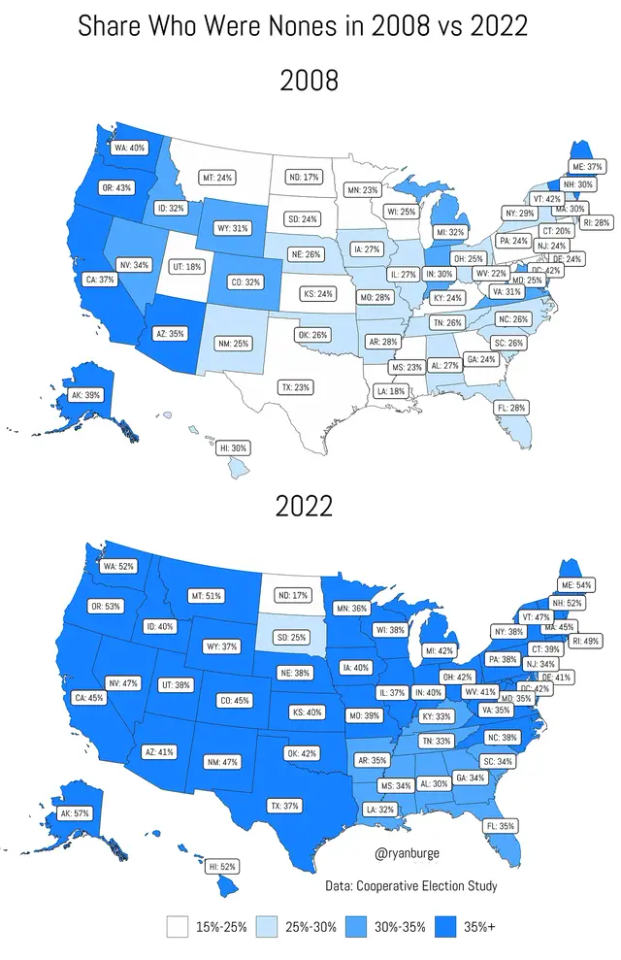
Share who identify as atheist, agnostic, or nothing in particular in 2008 vs 2022
681 notes
·
View notes
Photo

“It has been well said that mythology is the penultimate truth--penultimate because the ultimate cannot be put into words. It is beyond words. Beyond images [...]. Mythology pitches the mind beyond that rim, to what can be known but not told”.
- Joseph Campbell.
*The cave of Altamira.
#Joseph Campbell#Myth#Mythology#Altamira#Jung#Carl Jung#collective unconscious#archetypes#dreams#shadow#hero#ego#Europe#paleolithic#prehistory#solutren#European Early Modern Humans#REligion#Religiosity#pre-indoeuropean#European tradition#Eternal values#Salutreans#Animism#solutrean#solutreans
179 notes
·
View notes
Text
https://royalsocietypublishing.org/doi/10.1098/rspb.2021.2474
Men are less religious in more gender-equal countries
By: Jordan W. Moon, Adam E. Tratner and Melissa M. McDonald
Published: Feb 2, 2022
Abstract
Sex differences in religiosity are cross-culturally common and robust, yet it is unclear why sex differences in some cultures are larger than in others. Although women are more religious than men in most countries, religions frequently provide asymmetrical benefits to men at the expense of women. Two global analyses (51 countries and 74 countries) found that country-level gender equality was consistently and negatively associated with religiousness (i.e. religious attendance, reported importance of God and frequency of prayer) for men, more than for women, leading to a larger sex difference in religiousness in more gender-equal countries. Results were especially robust for religious attendance, and hold accounting for country-level wealth, as well as individuals' religious affiliation, the moralization of sexuality, age and education level. We interpret results through a rational choice lens, which assumes that people are more drawn to religion when it is consistent with their reproductive goals.
Men are less religious in more gender-equal countries
Sex differences in religiosity represent one of the most consistent findings in the psychology of religion, and are often described as nearly universal [1,2]. Some researchers have suggested that women (versus men) are more prone to religious beliefs because they have a greater propensity for mentalizing (the ability to reason about and represent others' minds) [3], decreased risk tolerance [4] and greater empathic concern [5]—all of which are associated with greater religious belief. Yet women are not always more religious—in some cultures, these differences are minimal or even reversed [6–8]. As of yet, it is unclear why there is cultural variation in sex differences in religiosity.
We draw on the rational choice model of religious engagement, which suggests that people adopt religious beliefs and practices depending on whether their goals are congruent with religious lifestyles [9,10]. We also take a functional approach, based on the premises that religious beliefs and practices are sensitive to context or ‘facts on the ground’ [11,12]. That is, rather than providing only symbolic benefits or comfort, many religious beliefs and rituals may be tools that developed through cultural evolution because they promote reproductive success.
In particular, religions seem closely linked to the control of reproductive behaviour. Most religions impose rules about sexuality and sex roles—who can have sex and with whom, who cares for children and how families are structured [12]. One of the most consistent correlates of religiousness worldwide is an opposition to sexual promiscuity (i.e. restricted sociosexuality [13,14]). A rational choice approach might predict that people who prefer high-investment, long-term, monogamous mating strategies will be drawn to religion precisely because it seeks to make sexual promiscuity more costly though anti-promiscuity norms and punishment [9,15,16]. None of this is to suggest that religion is necessary to control others' sexual behaviour, but that supernatural enforcement is one of several cultural tools of social control—one that is particularly powerful [17].
There is indeed evidence that religious norms and practices can affect several life-history trade-offs [18]. All organisms must choose how to allocate energy into growth, somatic maintenance and reproduction—taken holistically, there is a fitness trade-off between future and current reproduction [19]. This can be conceptualized as spanning three fundamental trade-offs: current versus future reproduction, quality versus quantity of offspring and mating versus parenting effort [20]. To the extent that religions increase paternal certainty [21,22], they can increase the incentives for men to invest in parenting [23,24]. There is also a trade-off between offspring quality and quantity, such that greater numbers of offspring are generally associated with less investment in each child [25]. This trade-off seems to be less steep among religious individuals, however, probably as a result of increased biparental care and alloparenting, in which parents, extended relatives and non-relatives provide care and resources for offspring [26,27]. Thus, religion can be especially appealing to individuals following these high-investment mating strategies, whereas people who seek sexual promiscuity may benefit more from eschewing religion.
What are the benefits of religion for women? Women invest more in offspring than men (e.g. nine months of pregnancy as well as time spent in child care), and are more discriminating in selecting mates [28,29]. Mate choice is the best way for women to advance their reproductive fitness; the regulation of monogamy that religion often affords protects that choice by incentivizing their partner to invest in their relationship and offspring. Indeed, because some males are more sought after as mates than others, these high-quality males have higher reproductive rates than females, and benefit from minimizing their investment across many offspring [30]. One straightforward benefit of religion for women, then, is it can prevent the desertion of high-value mates. That is, religious norms make it more costly for men to abandon their current mates or offspring by imposing sanctions or social pressure. This is especially true for religions that promote normative monogamy, which causes a more equitable distribution of mates [31]. In sum, women tend to be more interested in long-term exclusive relationships than men [28], and religion might appeal to them for this reason. This seems to partially explain sex differences in religiosity: some analyses have found that sex differences in religiosity disappear or are reduced when accounting for sociosexual attitudes [16].
However, religious norms often go beyond simply prohibiting promiscuity, and many religious practices seem to benefit men at the expense of women. This asymmetry can take several forms. Women may be blamed for their own rape [32] and held responsible for the sexual misconduct of men (e.g. through rules about modesty). Specific religious rituals or taboos may also benefit men at the expense of women—several scholars have outlined how veiling seems more consistent with male (versus female) interests, for instance as a tool for mate guarding [33–36]. Further, some rituals seem designed specifically to suppress female sexuality. Among the Dogon of Mali, the indigenous religion promotes menstrual taboos, which includes women being exiled in uncomfortable menstrual huts. Use of these huts (e.g. after a woman's most recent childbirth) sends an honest signal that a woman is fertile, leading husbands and their families to engage in precautions to avoid cuckoldry (e.g. postmenstrual copulation). Genetic data reveal that men who practice the traditional religion, as opposed to other religions (e.g. Christianity), have significantly lower risk of cuckoldry [21].1
For men in particular, these religious benefits might depend on context. The extent to which women and men share equal rights, responsibilities and opportunities in society (i.e. gender equality) may alter the incentives for men and women to engage with religious beliefs and practices. In cultures with less gender equality, the subjugation of women to advance men's interests might be more acceptable—and women may also be less empowered to prevent their oppression. Thus, in these countries, religion might be more useful to men as a tool of social influence. By contrast, in more gender-equal cultures that discourage restrictive religious practices for women, religion may afford fewer reproductive benefits to men because they cannot impose social control over women, and thus religion is less appealing.
Consistent with this notion, we hypothesized that gender equality would interact with sex, such that sex differences in religiousness (i.e. women being more religious than men) would be larger in more gender-equal countries. We were agnostic about what would drive this effect, only that the relationship between gender-equity and religiousness would be more negative for men than it is for women. We note, however, that many wealthy countries tend to have greater gender equality and are often more secular [41], so it would be surprising to find a positive slope for either men or women.
Our hypothesis was derived by considering several recent findings documenting a ‘gender equality paradox’—in more egalitarian societies, sex differences are often larger. This pattern has been found with sex differences in personality [42,43], moral judgements [44], career choice [45,46] and a variety of aesthetic preferences [47]. This pattern is perceived as paradoxical, as many people would intuit that gender equality would reduce inequalities or allow boys and girls to be socialized in ways that result in greater similarity. A common explanation is that egalitarian societies allow individuals to make their own decisions with fewer institutional barriers and less regard for what others might think. Rather than leading to the same outcomes for men and women, it allows them to express their diverging preferences, thereby resulting in greater sex differences [47–49].
Sex differences in religiousness may follow a similar pattern. In societies with less gender equality, men may be better able to derive reproductive benefits from religion, resulting in higher religiousness among men. For women, however, the benefits of religious behaviour may be less dependent on the cultural context; for instance, religious groups tend to provide more frequent alloparenting, and this might be the case regardless of a society's gender equality; in fact, the benefits of alloparenting could be even larger in more egalitarian societies, where people are less embedded in kin networks that might otherwise engage in alloparenting [26]. That is to say, because women can acquire substantial reproductive benefits from religious involvement, there may be greater incentive for women (compared to men) to be religious, particularly in societies that have achieved greater gender equality (figure 1).

[ Figure 1. Global Gender Gap Index (2018) scores by country [50]. Higher scores (darker colours) indicate greater gender equality. Countries with no data are in grey. Figure created using the rworldmap package [51]. (Online version in colour.) ]
[..]
Discussion
These data show that gender equality across cultures consistently and negatively predicts religious belief and behaviour among men, but the effect is small and inconsistent for women. This interaction between gender equality and participant sex holds in most of the models we ran, even when accounting for the clustering of countries within sub-regions, the religious denominations of participants, sociosexuality, age, education and country-level wealth.
The results were particularly strong with religious attendance as an outcome; in all such models there was a consistent negative relationship between gender equality and religious attendance for men, but no effect for women. We suggest that religious attendance (versus private religious behaviour or belief) is the outcome most relevant to our hypothesis. That is, it is attendance and overt participation that we would expect to be associated with the reproductive outcomes of interest. Overt religious participation may allow men to more easily monitor women, police sexual behaviour or to signal their value as a mate via religious commitment.
In addition, the focal results were driven by gender equality in education and economic participation, but not political power or health/survival. These results could be consistent with the view of religion as a ‘costly signal’ to indicate qualities such as trustworthiness, dedication to one's family or even simply dedication to one's group [7,37–39,62–64]; gender equality might also influence the payoffs of using religion as a costly signal. For instance, there is some evidence that women's economic dependence on men—which makes paternal certainty more critical—facilitates moralization of promiscuity [65]. It follows, then, that women who are dependent on men (i.e. when gender equality is low) may prioritize signals of paternal investment and long-term commitment; this could, in turn, incentivise men in these societies to use religion as a signal of their willingness to invest in their offspring [7,39].
One could also predict the same pattern by considering other functions of religion. For example, religion fosters cooperation and ingroup cohesion [66,67] and can help people manage their existential insecurities [41]. Indeed, religions are especially attractive to people after facing mortal threats, such as intergroup conflict [68]. One alternative explanation, then, could be that countries that have achieved greater gender equality face fewer threats that require male coalitional coordination (e.g. warfare); therefore, people (particularly men) in these countries are less likely to view religion as necessary. We reiterate, however, that our analyses are unable to reveal the mechanism behind the observed effects, or to adjudicate between alternative explanations.
Our hypothesis stems from a rational choice perspective on religion [9], suggesting that engagement in religious behaviours and beliefs might stem partly from the reproductive benefits people acquire from them [9,16,18]. Because religions often involve costly behaviour [69,70], one should expect religious engagement to be more likely when the benefits outweigh the costs. If indeed one of the functions of religion is reproductive support that often favours men over women, and if the manipulation of women in such ways (e.g. through modesty norms or proscribing sexual promiscuity) is less accepted in more gender-equal societies, the costs may outweigh the benefits for men in these societies, resulting in lower religiousness among men.
16 notes
·
View notes
Text
Apollo Robbins said he was raised religious but became an agnostic, and I was raised agnostic but became an atheist. And now I'm wondering how this is with other people
20 notes
·
View notes
Text
Okay so let it be known that at time of posting I have only seen the live action The Untamed, haven’t gotten through any of the other versions. I just need to let out a feeling about Lan Zhan.
Religious/devout characters are my kryptonite, and I love Lan Zhu specifically as a devout (is that the right term?) person who ends up at odds with the highly structured rules of his clan. Like I feel this deep attachment to that journey and that aspect of him that I barely know how to explain??
PS here he is with a BUNNY. On a Buffy to Untamed spectrum, how much do you like bunnies?

#lan zhan#lan wangji#elvella watches the untamed#the untamed#religiosity#devotion#i’m gonna call lan zhan an angel ok#also give him all the bunnies
10 notes
·
View notes
Photo

Democratic nations in particular place great value on the principle of tolerance, especially the tolerance of religious expression. The US Bill of Rights guarantees citizens the right to free exercise of religion.
Unfortunately, some people take the notion of equal toleration of religious expression to mean that all religions are equally true, thus equally valid paths to God. In effect, democracy has been applied to ultimate truth. This seemingly “politically correct” approach to religion, though popular, represents deeply convoluted thinking.
The acceptance of social pluralism (tolerance of diverse religious expression) does not logically imply the truth of metaphysical pluralism (that all religious truth-claims are equally valid and simultaneously true).
Careful examination of the basic tenants of the various religious traditions demonstrates that, far from teaching the same thing, the major religions have radically different perspectives on the religious ultimate. [Harold A. Netland]
Christianity affirms that redemption in Christ for the believer involves an eternal personal relationship with God in the afterlife. Hinduism, on the other hand, affirms a cycle of rebirths leading ultimately to the absorption of one’s individual consciousness into God or ultimate reality. Those two visions of future reality are simply irreconcilable.
Therefore, it is highly misleading to speak as if all religions share a common soteriological good and simply differ on the means to reach it; leading to a growing consensus that it is seriously misleading to regard the various religious traditions of the world as variations on a single theme. [Harold A. Netland; Alister E. McGrath]
Homogenizing religions is a costly price to pay to eliminate religious diversity, for in the end, the religions must sacrifice the very features that make them unique and appealing in the first place; meaning, “all religions are NOT basically the same… for as soon as [the notion of sameness] moves beyond vague generalities—every religion has some version of the Golden Rule—if founders on the fact that the religions differ in what they consider essential and nonnegotiable.” [Huston Smith]
Therefore, formal laws of logic firmly demonstrate the impossibility that all religious truth claims can be true at the same time and in the same way (the law of non-contradiction: A cannot equal A and non-A). For example, Jesus Christ cannot both be God incarnate (Christianity) and not be God incarnate (Judaism, Islam) at the same time.
To reiterate, contradictory religious claims have opposite truth value, meaning that they negate or deny each other. Therefore exactly one is true and the other false. And, accordingly, Jesus Christ must either be God incarnate or not be God incarnate; no middle position is possible (the law of excluded middle: either A or non-A).
Since Jews, Christians, and Muslims all conceive the identity of Jesus of Nazareth differently (human teacher, thus blasphemer; God-incarnate; human prophet), logically speaking, their conceptions simply can’t all be true. While it is logically possible that all three positions are false, they definitely cannot all be true. Thus, the claims of popular religious pluralism fail to comport with the self-evident laws of thought, confirming that;
“Anyone who would become a pluralist must first abandon the very principles of logic that make all significant thought, action, and communication possible.” [Ronald H. Nash]
In essence, to divorce oneself from the self-evident laws of thought when it comes to ultimate reality is to resign oneself to irrationality; a price too great for most people to pay because it requires the, “forfeiture of the possibility of meaningful affirmation or statement about anything at all––including statements about the religious ultimate.” [Harold A. Netland]
~ Samples, Kenneth Richard. ‘Without a Doubt: Answering the 20 Toughest Faith Questions
15 notes
·
View notes
Photo

"A hypocrite wants to impress others with an external façade of religious piety that he knows is devoid of internal spiritual substance."
- Sam Storms
29 notes
·
View notes
Text
[Costume Contextualization] Watch me Traveler, you will be Full of my Wisdom (Nahida Trilogy – Costume)
Hello everyone, I am AdolShadow. I am a religious studies scholar currently studying at NYU who loves Genshin and writes content on Genshin's digital historiography.
This is my first time posting on Tumblr. I am hoping to translate some of my work from other platforms here. As a scholar, I am not only into studying Genshin. I also do research on Sekiro: Shadow Dies Twice, Detroit: Become Human, and many other video games. I am hoping to know other game historians and anyone who is into researching games. I want to befriend all of you and talk about games happily! Thank you all very much in advance.
In this article, I will talk about Nahida. Of course, she has a lot of information in Genshin. Therefore, I will break the sections into the costume’s contextualization, Nahida’s context as a Dendro God in the historical writings, and how Nahida fits the historical background of Sumeru.
Whether it's Raiden, Venti, or Zhongli, Hoyoverse has put a lot of effort into designing Archons. Without further ado, let's take a look at what historical background and culture were referenced in the design of Nahida's costume.
If you like the content, please like and leave a comment below. I actually have a lot of similar content on my Hoyolab channel. Please take a look. I will soon translate more content here.
Hoyolab: https://www.hoyolab.com/accountCenter/postList?id=102330380
========================= Section Break ========================
Physic of Purity

With pure white clothes and green embellishments, the appearance of Nahida reveals its freshness and purity. In the past 500 years, she has neither experienced the pain of World Tree rot nor witnessed the cruelty of the war in Khaenri'ah. Nahida is undoubtedly happy by her “ignorance” of the world. However, being imprisoned since birth also means that she has never been in contact with the real world and has never used her body to touch or feel it. Therefore, the newly born green and pure white can just reflect Nahida's pure heart and newborn vitality.
Let’s take a look at the picture in detail to find out what is worthy to discuss on Nahida’s costume:

The first thing to notice is the pattern on Nahida's cloth. This dense and characteristic pattern is derived from Persian stained glass. The decoration on Nahida's head comes from the artifacts – Deepwood Memories, but the flower of life part, Labyrinth Wayfarer has a special meaning for Nahida. Additionally, I subjectively think that the material of the Nahida bracelet is brass. The Persian craftsmanship can also be seen in the decorations of the brass on the body and feet. Last but not least, the overall green color comes from the characters of the Persian New Year – Amu Nowruz, [1].
========================= Section Break ========================
Persian Stained Glass
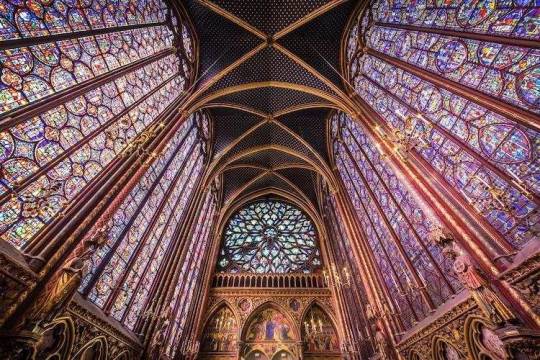
(Stained Glass [2])
Stained glass is the procedure of adding metallic oxides in the glass making, which gives the glass colors. Different oxides will give the glass different colors, making an appealing visual effect. The earliest stained glass can be traced back to the craftsmen in ancient Rome, but what I want to talk about here is the stained glass technology introduced to Persia in the 8th century.
In his book The Book of the Hidden Pearl, Persian craftsman Jābir ibn Ḥayyān explained the processes and materials required for making various colored glass [3]. Through this book, the stained glass of Persia is slowly shown to the public. In Sumeru, we can see its displays in various ways. Under the context of Nahida, stained glass is used to portray the beautiful space of the ult, Illusionary Heart.
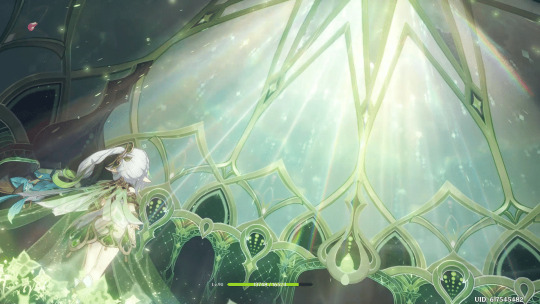
In fact, the clothes of another Genshin character also displays Persian stained glass craftsmanship. She is the "young" and “beautiful” scholar, Faruzan.

========================= Section Break ========================
Heart of the Labyrinth

(Labyrinth/ Maze [4])
Labyrinth was mentioned in one of my previous articles LINK (It is in Chinese). In that article, I roughly talked about the etymology of Labyrinth, which is originally built by the early Greek, Daedalus, as a gift to the King Minos of Crete. Labyrinth is designed to constantly change, and the entrance traveler enters does not necessarily become the exit when the traveler wants to come out. Labyrinth, indeed, is an ever-changing object.
I mention the labyrinth in this article because of the artifact, Deepwood Memories. Among them, the name of the flower of life is Labyrinth Wayfarer. Through the story of the flower of life, we understand that it belonged to the first maiden to follow in the footsteps of the King of trees through the forest labyrinth. In order to guard the king's labyrinth, she must hunt and defend it all the time. In this process, she protected many children who got strayed into this labyrinth. She passed down this tale of herself and the hunt to the children when they left the labyrinth. The story of her then reached to people's ears.
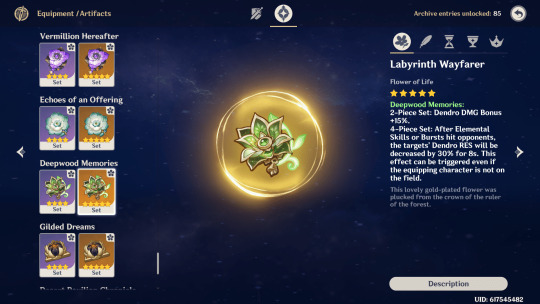
Although I don't think the maiden here refers to the Goddess of Flowers, the story of the flower of life plus the maiden who follows the King of the forest do have a little too much connection at here. Well, not to discuss that, what needs to be pointed out here is that in addition to the above-mentioned characteristics of the “maze,” where people get in and get lost, “Labyrinth” beyond the sense of a maze also guides you into its center.
Lauren Artress said, "A maze is designed to make you lose your way, while a labyrinth is designed to help you find your way" [5]. Therefore, in the labyrinth of Kind of forest, visitors who enter even by accident should not be afraid. The Labyrinth designed by the King will lead visitors to the center and increase their knowledge, rather than make things difficult for them. Doesn't this coincide with the theme of the Lord of Wisdom, Nahida?
========================= Section Break ========================
Brass Artifacts

(Persian brass bowl [6])
Persia is not only superb in stained glass craftsmanship, but also in the production of metal utensils, especially silver ones. However, it should be noted here that the historical background of Sumeru is likely to be referred to the Sasanian Empire from the 3rd to the 7th centuries, in which glass craftsmanship talked above is included. However, most of the Persian brass crafts that I can find came from Ilkhanate around the 13th century, which is Persia under Mongolian control. Because the time is not lining up, I don't want to be absolute here. I think the bracelet and anklet on Nahida are brass work, but I'm not sure. (But if it is a silver craft, then it for sure aligns with Sasanian Empire)
In addition to the obvious brass-colored products on Nahida's body in Sumeru, Nilu also has some brass-colored decorations. However, it can be seen from the comparison that Nahida's bracelets obviously have more textures, which shows its exquisite craftsmanship.

Due to the invasion of Islam around the 7th century, the great Sasanian dynasty ended. The use of silverware and goldware in the Arab Empire was particularly regulated, so the Persians had to give up the use of large numbers of silverware as daily necessities. At this time, a method to replace silverware appeared, which is using the base of copperware with silver inlaid [7]. Such silver-inlaid products have many applications in Persian life, such as kettles, clocks, bowls, teapots, and bracelets [8].
========================= Section Break ========================
Nowruz

(Nowruz [9])
Persians’ New Year's day, Nowruz, falls on March 21st every year. This holiday belongs to the vast majority of Middle Eastern countries and cultures [10]. For example, my girlfriend will light candles, set up tributes, and celebrate the New Year at this time of year.
In this festival, there is a special person, his name is Baba Nowruz or Amu Nowruz. He is like Santa Claus, coming into the crowd, bringing gifts to children, and welcoming the New Year with them.

(Grandpa Nowruz [11])
Looking at his green coat, it is similar to Nahida's color pattern. Although this does not mean that there is a direct connection between them, if we bring in the concept of the "Sabzeruz Festival", it will the connection clearer.

Sabzeruz Festival, in fact, is related to the Persian New Year in multiple meanings. Sabzeh Nowruz, sprouted wheat, is one of the seven items that need to be prepared on Nowruz [12]. “Sabze” in its meaning is “green,” and “ruz” refers to “day.” Therefore, Sabzeruz Festival actually means Green Day, not really the birthday of the goddess of flowers. However, considering the birthday of the Nahida and the meaning of green as new life, the birthday of Nahida should actually refer to Nowruz, the Persian New Year. Therefore, the green color pattern of Nahida probably has a good connection with Baba Nowruz.
========================= Section Break ========================
What’s Next

After talking about the costume of Nahida, I should probably give you a teaser about what is coming next. The second part of the trilogy will be the background and textual research of Nahida, this name and its meaning.
Have you ever thought about the etymology of “Kusanali”? In fact, it comes from the Kusanali Jataka of Buddhism. What about the name, Nahida? It is actually derived from the Persian goddess “Anahita.” Hmm, what about “Rukkhadevata”? Well, that one is basically given in English, because in Hinduism, Rukkhadevata means tree spirit. Finally, “Beur,” the archon name, is our dear friend, Lesser Key of Solomon’s 72 Demon God, Beur. Wow, the name Nahida is so complicated and interesting. Don't you want to know more about the secrets inside Nahida? Stay tuned then!
PS : Thanks to my girlfriend Shah for some of the info here. She gave me a lot of inspiration and information on many art designs of Sumeru (the part with Persian culture).
========================= Section Break ========================
Reference :
https://en.wikipedia.org/wiki/Amu_Nowruz
https://mymodernmet.com/stained-glass-history/
Resources are the same as 2
https://earthandaltarmag.com/posts/qs6pevk77i0lhpqlvv8w0u23f1sbwk
The resource is the same as 4
https://elizabethappraisals.com/brass-bowl-in-style-of-ancient-metalworkers/
https://persianhandicrafts.com/blog-posts/?journal_blog_post_id=19
Resources are the same as 6
https://www.un.org/en/observances/international-nowruz-day
Resources are the same as 9
Resources are the same as 1
http://www.mypersiankitchen.com/sofreh-haft-seen-the-7-s-of-norouz-spread/
Extra : Sabze ruz Festival, Genshin Wiki, https://genshin-impact.fandom.com/wiki/Sabzeruz_Festival
#genshin impact#hoyoverse#nahida#lesser lord kusanali#persian#art design#historiography#etymology#sumeru#video games#video game history#religion#religiosity#religious#costume
26 notes
·
View notes
Link
EXECUTIVE SUMMARY
Digital platforms, new media, and popular culture have diversified Muslims’ production and consumption of religious content, their forms of religious expression, and even their religiosity.
Tech-savvy and proactive young Muslims who seek and reproduce religious knowledge outside traditional and institutional structures are at the core of this socio-religious transformation.
This article examines young Bruneian Muslims’ production and consumption of religion-related content on social media sites. It elucidates how they, as new religious agents, are altering the lived socio-religious realities and landscapes in the country, which upholds the Melayu Islam Beraja (Malay Islamic Monarchy or MIB) ideology.
Although new religious practices have emerged, and the young have become agents of religious transformation, this article contends that the role and significance of traditional religious authorities in Brunei society remain strong.
When portraying their religious identity, the youths continue to observe self-restraint and be guided by the dominant state narrative. In that way, they avoid undermining the MIB and also suffering any backlash from a community that continues to practise ground-up surveillance.
*Siti Mazidah Mohamad is Visiting Fellow at the Regional Social and Cultural Studies Programme, ISEAS – Yusof Ishak Institute. She is an Assistant Professor and Director for the Centre for Advanced Research (CARe) at Universiti Brunei Darussalam, research Muslim youth culture and engagements with popular culture and new media in Southeast Asia.
Download PDF Version
6 notes
·
View notes
Text
New Post has been published on Books by Caroline Miller
New Post has been published on https://www.booksbycarolinemiller.com/musings/thoughts-on-invictus/
Thoughts On Invictus*

Surrounded by books in a well-trafficked bookstore, I sat down to coffee with a former student. We’ve been meeting this way for many years. By now, he is in his early 70s while I am staring down at 87. Happily, we are both in robust health, and I always look forward to our conversations, particularly on that day as he’d recently returned from a year in Japan. As he related his experiences about life aboard, I noted he spoke in a booming voice as though his words needed to carry to the back of a large hall. As we were seated at a pedestal table no more than 3 feet apart, I took exception. “Why are you yelling at me? I can hear you perfectly well.” My companion paused, his features creased in a puzzled expression. “I’m sorry. I thought you might be hard of hearing.” He was right in his assumption. I am hard of hearing which is why I wear earbuds that are as expensive as diamonds but without the glamor. At 104, my mother could hear a fly drop on a marshmallow at twenty paces. Sadly, I follow in my father’s footsteps. His hearing loss began in his 50s. Even so, he refused to see a doctor and seemed to delight in forcing friends and family to shout at him. Rejecting his example, I take pity on those around me and wear my hearing aids when I’m in public. The doctor says I should wear them all the time, but they make my ears itch. In any case, my point about the difference between my mother and father makes one thing clear. People don’t age in the same way. Hopefully, my mother’s genes will bestow a long and healthy life on me but science gives me no assurance. Genes, they say, have a 10-35% influence on longevity. The rest depends on diet and exercise. Those born at the tag end of the Baby Boomers and the generations that followed probably see 80-somethings as prehistoric. Born before the advent of television, we are folks presumed to live in the shadows, figures bent like candy canes who shuffle about unobtrusively with the aid of wheelchairs, walkers, or canes. Would it surprise them to learn that Helen Mirren, age 78 and two years younger than President Joe Biden, made 5 films this year? (“Up/front Watch,” AARP, Aug/Sept. 2023, pg. 12.) Or, that in his two years in office, Biden has fulfilled so many campaign promises historians predict he will be remembered as one of the country’s ablest presidents? Marjorie Taylor Greene, Georgia’s Republican member of Congress, disagrees with that assessment. She roots for Donald Trump, age 77, to win the 2024 Presidential election. Not only blind to Trump’s age, his previous presidential failures, and the many court indictments pending against him, she insists a higher power works in his favor. God has plans much bigger than this. (“They Said What?” FreeTought Today, September 2030, pg. 2) If the past is a prelude to the future, I shudder to think what these plans may be. True, a significant swathe of the country shares Greene’s view. Like her, they don’t have the force of the pulpit behind them, but they claim to know God’s will and are determined by means fair or foul to convert the rest of us to their religiosity. They proselyte on social media, shout their hallelujahs over public school and prison speakers (Ibid pgs. 5-6), as well at sporting events–any place where they find a captive audience. Nature thrives on diversity, but their God demands conformity. With each book banned from a school or library, these zealots celebrate– as if free will and free thought were worthy of a public hanging. By degrees, their successes rob the world of color. Once invention, imagination, and originality become exiles, we find ourselves confined to a grey pallet– a place of shadows where fear and hatred are free to spin their mischief. The average lifespan for our species is 74 years. Measured in days, that represents 272,000 sunrises. Compare this number to the life of our sun which will burn another 4. 57 billion years. Given the contrast between it and ourselves, a question arises. Can we afford to be profligate with our brief hour upon the stage? Whether young or old, rather than busying ourselves judging others, we’d do better to contemplate our common destiny and how our actions make either heaven or hell of the earth. The journey each of us takes may be private, yet we know it has public consequences. A good rule of thumb might be to consider looking inward and holding ourselves accountable for the good or ill we do. Only when we have shouldered that burden as a compass can we claim to be captains of our souls. *Poem by William Ernest, Henley
#age discrimination#average life span#benefits of diet and exercise#Donald Trump#Helen Mirren#intolerace breeds hate and fear#Invictus#Joe Biden#longevity#Marjorie Taylor Green#prejudice#religiosity#taking responsibility#what humans owe each other
3 notes
·
View notes
Text
Intrigued by how my religiosity and spirituality increase when I take medications that increase my serotonin. Anybody else experience this?
#Psychology#Psychologie#Religiosity#Religiosité#Spirituality#Spiritualité#serotonin#Sérotonine#I didn't even take a psychiatric medication but this stuff has me making an altar to Apollon
2 notes
·
View notes
Photo
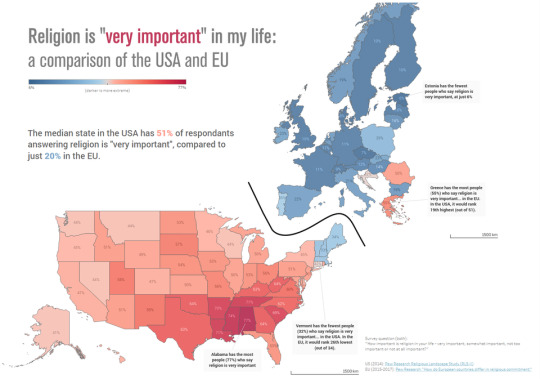
Is religion very important in your life?
1K notes
·
View notes
Text

We are as strong as our spiritual foundations. To transcend the decadence of the modern world, we must ascend toward those eternal values that, though rejected, have endured age after age.
#religiosity#myth#indo european religions#lauburu#revolt against the modern world#julius evola#tradition#traditio#mircea eliade#european values#traditionalism#nature#carl jung#europe
29 notes
·
View notes
Text

By: Buzzfeed
Published: Feb 12, 2023
We recently asked Black members of the BuzzFeed Community to tell us the reason they left Christianity. Here are their insightful replies:
Warning: This post contains mentions of sexual abuse.
1. "First, I never wanted to go to church, it was something my mom made us do. Second, homophobia. The last time I went to a church it was a lovely and inspirational sermon until the pastor started disparaging gays for absolutely no reason. Even at my grandfather's funeral, the pastor there managed to blame gays for the state of the world. Just random unnecessary hate."
—justchillman
2. "When I was younger, the pastor at the family church was allegedly involved in a scandal with a child and no one would do anything because he was a 'man of God.' I was instantly turned off of organized religion after finding out. That was the catalyst and the more I grew up and did some soul-searching, the more I realized I could not believe in a God that would protect a monster over a child (amongst other things as well)."
—sdhendrix182
3. "I stopped believing because my ancestors were forced to convert to what their masters believed. Plus, we pray so much and are some of the hardest believers, yet our lot in life remains the same generation after generation. I didn't understand why we were suffering so much even though we went to church and prayed so much. So, I stopped believing, stop praying and start doing and became very successful."
—Anonymous
4. "The amount of gossiping that went on in my church was astounding to me, even as a child. I always felt I had to be perfect or else I would give everyone else even more to talk crap about. The irony of the 'judge not lest ye be judged' Christians being the judgiest people I ever met was lost on them, but it made me really evaluate if I actually believed or if it was just putting on a show so I could fit in. I found out it was the latter."
—afinallullaby
5. "I was raised Catholic but as I got older, I questioned the church and its teachings more and more. A lot of it started to not make sense. When I discovered that I was nonbinary and pansexual, the church responded by forcing conversion therapy on me rather than accepting me. A God that supposedly loves everyone is not going to force that sort of hell on anyone."
—Anonymous
6. "I am a 60-year-old heterosexual African male and was increasingly bothered by the comments and jokes about gay people from the pulpit. I was a devoted and tithing member of a non-denomination mega church. My childhood years were spent every Sunday in a southern Baptist church. But I began to feel more and more uncomfortable with rhetoric that was justifying why gay lifestyles were 'unacceptable.' In short, I asked myself is this what Jesus would say or do with anyone or any group? My answer was no. This caused me to have enough doubt to question a number of teachings and stories in the bible that I was now able to look at with open eyes."
"I began to research the origins of religion and came to understand it is all about a belief, not facts. I then asked a basic question is there any area in my life where I operate on belief and not fact? With that in mind, I had to get honest and admit, I have no concrete data or facts that clearly show me there is a God. The idea of attributing what we don't understand to a God is no longer acceptable to me."
—Anonymous
7. "I grew up in church with pastors on both sides of my family. It's overwhelming as a child to be told all the things you can't do because it's a sin and you'll go to hell. Don't get me started on the teachings about relationships and sex. I wasn't allowed to date until I was 17 and once I turned 17, I was suddenly supposed to be okay with openly dating without feeling conviction. Religion played a huge part in me not dating or having significant relationships until my mid-20s and even then it still felt wrong."
"Additionally, end-time prophesy teachings (the rapture) were genuinely traumatizing. I was under constant fear that the rapture would happen and I would be left behind for some unknown sin I committed. I now have a child of my own and I REFUSE to put any sort of religious teachings in her head and I've told my parents that I will decide what's appropriate for her until she's old enough to make her own decision about religion."
—Anonymous
8. "At a very young age, I was forced to attend church. It felt like a cult. I was cognizant of the so-called church body I convened with. All I did was look and listen. Attending church continued until I was in my early teenage years. After all that I have experienced and been through I made a conscious decision that I did NOT want to be in the same place with any of those people which I will never do."
—Anonymous
9. "I didn’t grow up in church or a religious household, I was just told God exists, sin exists, and went to a few summer bible schools. As an adult, I wanted to grow my faith. The more I started reading, researching, and contemplating, I called bullcrap. It took about three years of combing through Christianity, Black Hebrew Israelites, and belief in God with no attached religious text before I settled on atheism. Honestly, I never felt more at peace or free."
—Anonymous
10. "As I got older, a lot of things in the bible just didn't add up (no mention of dinosaurs, no one could give an exact timeline of the events in the bible, the fact that the whole origins of the bible itself are a matter of debate). Not to mention that Christianity was used to keep slaves in check. I definitely have been persecuted for my stance, but I will never go back to any religion."
—Anonymous
11. "I did research on the history of the church and became very knowledgeable on all its past. Once I understood the roots of the faith, it became impossible for me to logically subscribe to it."
—Anonymous
12. "I grew up in a Baptist church in a religious extended family. My belief in some higher power diminished because of multiple reasons. Multiple friends of mine died in the same year and I just can't fathom how a higher power allows so much grief and hurt (at a personal level as well as across all of society). Mass shootings, violence, homelessness, assault, and so many heinous acts get explained away by free will, but why let people suffer if an all-powerful being could make it better? Modern Christianity is so far from the teaching of the bible. Looking at the mega-churches and the pastor and their lavish lifestyles, they're businesses."
—Anonymous
13. "I was raised in the church and the older I get, the more it seems to me how religion is used just to control the less fortunate."
—Anonymous
14. "I would say that actually reading the bible for myself without someone else's interpretation led me out of Christianity. Once I read it fully, I saw how humans created a God in their image depending on their circumstances and state of mind. While Christians will believe their God is going to save us from ourselves, the work of being better stewards of the Earth and each other falls on us. We must evolve into better humans."
—Anonymous
15. And "I was baptized at 12 and literally a year later I started to question my faith. So I read the bible in full. So many questions that many refuse to logically answer besides the usual 'Have faith.' I have not found anyone that can explain to me why God needed to kill all the animals except for the only two of own their kind on Noah’s ark when it was the humans who sinned. So many inconsistencies and not to mention man has touched the bible. What better way to control people than saying promises of heaven or being condemned to hell? I consider myself an agnostic atheist."
—Anonymous
Submissions have been edited for length and/or clarity.
==
Black Americans have consistently tended to be more religious and slower to leave their religion per capita than white people and other ethnic groups, and more likely to regard religious faith as being personally important.


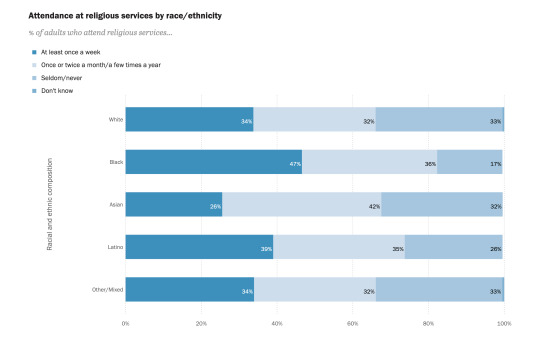
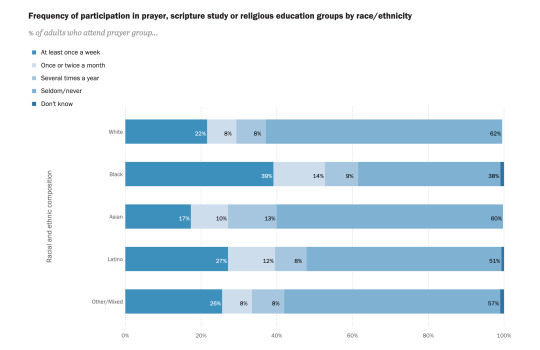
[ Source: https://www.pewresearch.org/religion/religious-landscape-study/racial-and-ethnic-composition/ ]
But perhaps that trend might change.
#black americans#religion#christianity#decline of religion#empty the pews#religiosity#decline in religiosity#religion is a mental illness
57 notes
·
View notes
Text

The worst kind of ableist.
If bipolar disorder is demonic possession, the Tegretol is the power of Christ.
2 notes
·
View notes
Text
The Bible Is a Horror Novel & Other Tees Live on the store on Etsy!
#atheism#atheistpride#atheistmerchandise#atheistfashion#bible shitpost#bible study#anti christianity#bible#bible verse#christianity#anti religion#ex christian#atheiststyle#exvangelical#ex fundie#religiosity#christian nationalism
2 notes
·
View notes